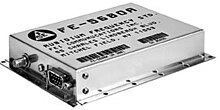Rubidium standard

A rubidium standard or rubidium atomic clock is a frequency standard in which a specified hyperfine transition of electrons in rubidium-87 atoms is used to control the output frequency.[1]
Synopsis
The Rb standard is the most inexpensive, compact, and widely produced atomic clock, used to control the frequency of television stations, cell phone base stations, in test equipment, and global navigation satellite systems like GPS. Commercial rubidium clocks are less accurate than caesium atomic clocks, which serve as primary frequency standards, so the rubidium clock is a secondary frequency standard.
All commercial rubidium frequency standards operate by disciplining a crystal oscillator to the rubidium hyperfine transition of 6.8 GHz (6834682610.904 Hz). The intensity of light from a rubidium discharge lamp that reaches a photodetector through a resonance cell will drop by about 0.1% when the rubidium vapor in the resonance cell is exposed to microwave power near the transition frequency. The crystal oscillator is stabilized to the rubidium transition by detecting the light dip while sweeping an RF synthesizer (referenced to the crystal) through the transition frequency.
See also
References
- ^ Riley, William J., Jr (December 2019). "A History of the Rubidium Frequency Standard" (PDF). IEEE Uffc-S. Archived (PDF) from the original on 2022-10-09.
{{cite journal}}: CS1 maint: multiple names: authors list (link)
Bibliography
- Stanford Research Systems documentation on the PRS10 frequency standard
 This article incorporates public domain material from http://tf.nist.gov/general/enc-re.htm#resonancefrequency. National Institute of Standards and Technology.
This article incorporates public domain material from http://tf.nist.gov/general/enc-re.htm#resonancefrequency. National Institute of Standards and Technology. {{citation}}: External link in|title= This article incorporates public domain material from Federal Standard 1037C. General Services Administration. Archived from the original on 2022-01-22.
This article incorporates public domain material from Federal Standard 1037C. General Services Administration. Archived from the original on 2022-01-22.
